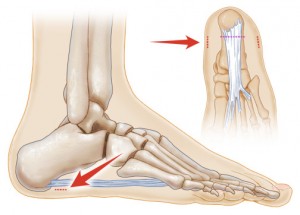Endoscopic plantar fascia release is a surgical procedure that involves cutting the plantar fascia ligament to relieve tension and inflammation (plantar fasciitis).
According to the National Institute of Health, approximately 20 percent of people with heel pain/plantar fasciitis undergo endoscopic plantar fascia release or some other type of surgical procedure to treat this problem.
However, up to 25 percent of those people may continue to experience pain, difficulty walking, and other symptoms associated with plantar fasciitis after the procedure.
The term endoscopic is used because of the arthroscope, an instrument inserted into the incision to enable the surgeon to see the entire plantar fascia ligament during the procedure. If an arthroscope is not used, the procedure is simply called plantar fascia release.

Who Needs Endoscopic Plantar Fascia Release?
Surgery for plantar fasciitis is reserved for severe cases only. In fact, it is estimated that only 5 percent of people with heel pain/plantar fasciitis receive surgical treatment.
Often this type of surgery is performed only after all non-surgical treatment methods have been exhausted, or if symptoms persist after a year of aggressive conventional treatment. Non-surgical methods may include:
- Stretching and physical therapy
- Corticosteroid injections
- Taping
- Orthotics such as heel pads
- Extracorporeal shockwave therapy
- Anti-inflammatory medications (steroidal and non-steroidal)
On the Day of Your Endoscopic Plantar Fascia Release Procedure
Your doctor will give you specific instructions prior to the procedure—whether or not to drink or eat on the morning of the procedure and how early to arrive to the appointment. Instructions vary from patient to patient. You will need to designate a driver to take you home after the surgery.
After your surgery, you will be limited in the amount of weight you place on your foot, but you will not have to wear a brace or other type of orthotic.
Regular shoes may be worn again as soon as you can comfortably do so. Most patients who undergo this procedure are able to resume their normal activities within three to six weeks, although running and jumping are typically not allowed for up to three months after surgery.
Complications of the Endoscopic Plantar Fascia Release Procedure
Unlike traditional plantar fascia release, this procedure can sometimes cause complications such as nerve damage.
In order to prevent this, the surgeon may free the abductor halluces, the thickest part of the foot muscle, to prevent nerves from becoming entrapped during the healing process. This typically reduces the chances of nerve damage. Tarsal Tunnel Syndrome is another common nerve disorder that sometimes develops.
As mentioned above, 25 percent of people who undergo this last-resort surgical treatment will continue to experience pain. Although it is rare, some people experience worse symptoms following surgery. Infection at the incision site and delayed healing are also possible.
Talking to Your Doctor About Endoscopic Plantar Fascia Release
When meeting with your doctor, be sure to ask questions such as:
- Are there any other treatment options available other than surgery?
- Would I benefit more from endoscopic surgery or regular plantar fascia release?
- How long will the procedure take?
- When will I be able to drive again?
- Do I need to come back for a follow-up appointment?
- If pain persists after the surgery, what other options do I have?




